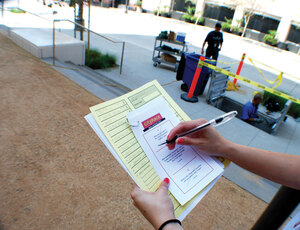CityRace: The Everyman’s Competition
Clue No. 1: “What three Downtown streets intersect where Saint Peter turns Japanese?”
This was CityRace. It wasn’t The Amazing Race, but it sure seemed like it on the Saturday morning in September when my team members and I — we cleverly called ourselves Team Daily Trojan — read the first clue and felt the adrenaline of competition. It was like a victorious Rocky scene, if the four of us girls could be muscular men. We didn’t know or care what the prize was, but we wanted it.
The localized scavenger hunt, CityRace, and it’s citywide counterpart, Race/LA, were created by John Hennessy to give people the real-life experience that those on reality shows like The Amazing Race are able to have: the rush of a race, the intensity of solving a puzzle or math problem and the feeling of accomplishment when it’s all over.
“The Amazing Race is totally my favorite show,” Hennessey confessed.
Hennessy began his hunt-organizing business with Race/LA, investigating and constructing all of the scavenger hunt’s clues on his own, and using volunteers and part-time staff members to help run the race itself.
“We surveyed everyone who did Race/LA when it was over and a lot of people told us that they wished there were more mental challenges than physical,” Hennessy said.
So while Race/LA aims to put on a day-long, physically challenging race that is completed mostly by car through all of Los Angeles, Hennessy created CityRace to give contestants a similar experience in less time but with more mental challenges. CityRaces are three-hour mini races and tours around a specific section of Los Angeles, like Little Tokyo or Hollywood, with no running, driving or physicality involved.
Although CityRace is more relaxed and can be completed in teams of two, three or four, Race/LA is done in teams of two and at least one member of the team must be 21 years of age. In essence, Race/LA is much more like the television show than CityRace, but both programs have been wildly successful (Race/LA has been running since 2004, CityRace since 2007) as a way for tourists and even native Angelenos to spend a day or less learning about Los Angeles in a more interactive way than sitting on a sightseeing bus.
At first, CityRace can seem like an impossible task (and Race/LA is likely even more daunting). If you’re anything like Team Daily Trojan, that first clue is enough to make you run far, far away and not even attempt the race. But Hennessy ensures that the races aren’t too difficult.
“After I create each of the races, I do a test run-through and make sure the clues make sense and aren’t impossible to figure out. Sometimes people are willing to test [the races] out for me after they have done CityRaces before,” Hennessy said. “And it’s only happened a few times where people couldn’t finish.
Even then, that was because they were sick or something, and left a message at our office.”
But especially since these races aren’t free (CityRace is $35 per person), why quit? Get to work, like my team members did, and continue reading the clue packet. While the first 25 clues may be altogether unintelligible, clue 26 may be able to get you started. Once a team finds just one answer — which they will, even if they know nothing about LA — momentum builds.
“I like when a team is really super competitive, because I think that’s how I would be. When people come and run from the start, it’s always exciting,” Hennessy said.
Our team did a little bit of running, but the clues were fairly easy to solve in three hours without running. Some clues were pictures or puzzles, while others were fill-in-the-blank type answers; a few were even math-related. After three hours, we were exhausted but satisfied. We had answered every clue and arrived earlier than other teams, which can be beneficial if two teams tie for first, since time is then taken into account.
Once everyone arrived back at “base camp,” Hennessy read off the answers to the clues — Clue No. 1 was looking for where San Pedro Street becomes Judge John Aiso Street at 1st Street — and announced the winners. We came in third place, losing to a team that had previously done a CityRace. Of course we ultimately wanted to win, but the experience itself was satisfying enough. For the price of dinner and a movie, we had learned more about Little Tokyo than we would ever need to know, and felt great about it.
“I want people to say that they had seen a part of the city they and never seen before,” Hennessy said. “That’s kind of the exciting thing about it — that people are always discovering new places.”

